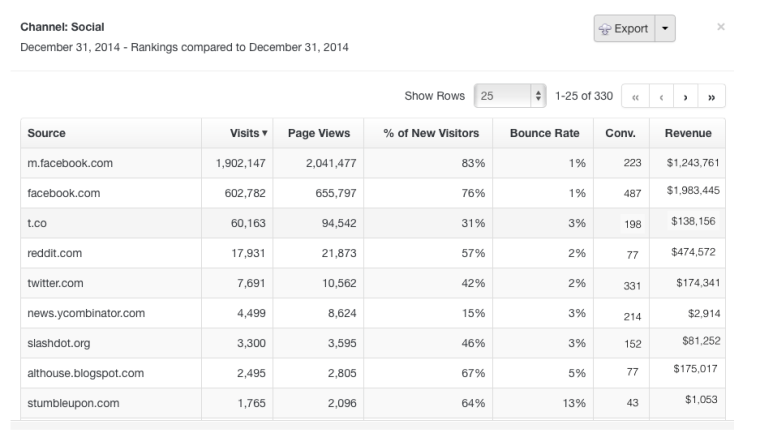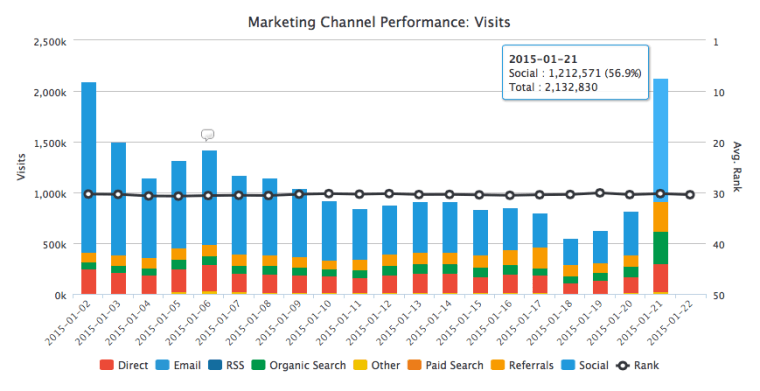Despite the potentially jargon-heavy title of this piece, we’re actually talking about serious stuff here – which is why you should know what you’re spending time and money doing is worth the time and money.
While I think that sentence alone should be a good reason, I’ll expand to three core reasons why knowing the ROI of your social media campaigns is paramount to marketing success.
Time + Money = ?
First up is a deeper dive into my initial statement: If you’re spending time on something at work, it needs to be valuable, and that value needs to be provable, preferably by tracking your company and team goals.
If it doesn’t, then you should ask yourself (or the powers that be) why you’re doing it. Without getting too existential about it, most people work for an organization that has some kind of goal, with metrics attached. From there, a trickle down effect of departments, teams, and individuals having goals/metrics/KPIs/whatever you call them, is fairly common.
Now I hear you saying that you have goals and metrics for your social media campaigns. I also hear you shouting, “Retweets!” and “Likes!” and “Pins!”
While there is nothing specifically wrong with wanting traction on social channels, a few important considerations should be applied:
- Do you know what a given number of Pins/Likes/Retweets/Whatever gets you in terms of meeting your overall revenue or company goals? How it contributes to sales, conversions, or lead generation?
- Do you know that the channels you’re using are the best possible channels for your brand?
- Do you know that you’re effectively allocating the right amount of time to each channel based on its ROI for your brand?
If yes, you are certainly not the norm.

Which brings us to our second point.
The Medium, the Method, and the Message
If you’re not tracking the ROI of your social campaigns, you probably don’t know what’s working, not working, and why. And you should definitely want to know that information, because it’s how you get to better marketing, higher ROI, and a strategic understanding of what the right mix of channels by audience is for your brand.
I often hear assertions about channels like, “YouTube is great for my brand!” or “Case studies don’t really work for this company.”
What’s concerning about statements like these is that I want to be sure that’s actually true and not an assumption based on improper measurement. While YouTube may be working great for your brand, there are a few more things to consider:
- Does all video content work well for your brand – have you placed the videos somewhere besides YouTube to see if those channels get good traction as well?
- Is it the content of the video that’s good, and if so, can you repurpose it into other mediums since it seems to be something that audiences gravitate toward?
- Could you be optimizing your YouTube channel further, taking good content to great content?
This is where the idea of the medium, the method, and the message come into play, and is especially great when we’re talking about social media because it has traditionally been really difficult for organizations to derive real ROI from each contribution.
An example of what each of these are could be:
- Medium: This is the channel you’re using to distribute your marketing. This includes things like Twitter, Pinterest, YouTube, Marketo, SlideShare, and more.
- Method: The method is the type of content or asset you’ve created. Examples include video, image, white paper, email, case study, podcast, e-book, landing page, etc. Be sure to note that we’re separating out the video itself from the place you share it (YouTube, Vimeo, your website, an ad, etc.) so that you can really measure whether it’s that video is awesome, or the medium you’re sharing it through.
- Message: This is the campaign or main theme you are trying to convey to the audience. For example, it may be “Black Friday Holiday Deals” or “New Sales Solutions.” This is how you measure the efficacy of campaigns, regardless of the methods and mediums you used for them. This comes in especially handy when you add new mediums or methods to a campaign and things either go great or flop – you can point to what specifically wasn’t working and make real adjustments.
I do this by tracking all of our social content in a matrix that takes into account each of the three items – medium, method, and message – and then I can compare and contrast them as I need to understand what’s working.

Ain’t Nobody Got Time for That
How do you know that you’re allocating your marketing time appropriately? This gets to a question of amplified or diminishing returns. Put a better way, if you spent another hour on that Facebook post would you get a return on that investment of time that is greater than what you would have gotten by spending the hour doing something else?
The answer may be that you should definitely perfect that Facebook post, but it may also be that you could have written two posts, worked on a Vine video, or even gone on a lunch break and still gotten the exact same traction regardless of additional time spent.
While this isn’t an exact science for most businesses yet, using the medium, method, message idea – you can start to see what is truly working for your business, and you’ll also notice much faster what’s not. From there, make adjustments with the volume of content, number of messages, etc. that marketing is working on. You should notice inflection points (the place where you start to go up or down in ROI) that tell you, “Hey, we’re starting to get somewhere with this.” Or, “Stop! We’ve spent too much time/money/over-messaged our audience and need to go back to the point where things were optimal.”
A Bad Apple Spoils the Bunch
If you are spending time (and therefore money) on social media campaigns you need to be know what they’re doing for your brand and how to capitalize on that. Whether you’re an agency, in-house marketer, executive, or contractor – if you don’t understand the ROI of your social media spend, then your reporting is probably inaccurate. And you can bet that if your reporting is inaccurate in social media then it’s inaccurate elsewhere, because no marketing effort exists in a vacuum.
Take the time to calculate and understand what’s happening with your social media campaigns – then use that information to optimize the rest of your marketing mix like email, SEO, advertising, etc., maybe even leverage it for better customer success and sales. Social is a great way to get instant feedback from an audience, so make ROI measurements count.





